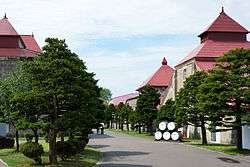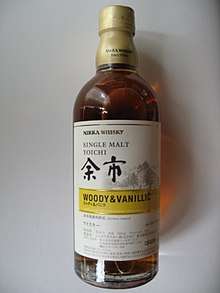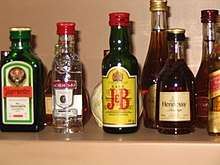Japanese whisky
 | |
| Type | Whisky |
|---|---|
| Country of origin | Japan |
| Introduced | c. 1870 / 1924 |
| Variants | |
| Related products | Scotch whisky |

Japanese whisky is a style of whisky developed and produced in Japan. Whisky production in Japan began around 1870, but the first commercial production was in 1924 upon the opening of the country's first distillery, Yamazaki. Broadly speaking the style of Japanese whisky is more similar to that of Scotch whisky than other major styles of whisky.
There are several companies producing whisky in Japan, but the two best-known and most widely available are Suntory and Nikka. Both of these produce blended as well as single malt whiskies and blended malt whiskies, with their main blended whiskies being Suntory kakubin (角瓶, square bottle), and Black Nikka Clear. There are also a large number of special bottlings and limited editions.
History
Two of the most influential figures in the history of Japanese whisky are Shinjiro Torii and Masataka Taketsuru. Torii was a pharmaceutical wholesaler and the founder of Kotobukiya (later to become Suntory). He started importing western liquor and he later created a brand called "Akadama Port Wine", based on a Portuguese wine which made him a successful merchant. However, he was not satisfied with this success and so he embarked on a new venture which was to become his life's work: making Japanese whisky for Japanese people. Despite the strong opposition from the company's executives, Torii decided to build the first Japanese whisky distillery in Yamazaki, a suburb of Kyoto, an area so famous for its excellent water that the legendary tea master Sen no Rikyū built his tearoom there.
Torii hired Masataka Taketsuru as a distillery executive. Taketsuru had studied the art of distilling in Scotland, and brought this knowledge back to Japan in the early 1920s. Whilst working for Kotobukiya he played a key part in helping Torii establish the Yamazaki Distillery. In 1934 he left Kotobukiya to form his own company—Dainipponkaju—which would later change its name to Nikka. In this new venture he established the Yoichi distillery in Hokkaidō.
The first westerners to taste Japanese whisky were soldiers of the American Expeditionary Force Siberia who took shore leave in Hakodate in September 1918. A brand called Queen George, described by one American as a "Scotch whiskey made in Japan", was widely available. Exactly what it was is unknown, but it was quite potent and probably quite unlike Scotch whisky.[1]
Distilleries
As of 2011, when the Shinshu distillery reopened, there are around nine active whisky distilleries in Japan.[2][3] These include:
- Yamazaki: owned by Suntory, between Osaka/Kyoto on the main island of Honshū
- Hakushu: also owned by Suntory, in Yamanashi Prefecture on the main island of Honshū
- Yoichi: owned by Nikka, on the northern island of Hokkaidō.
- Miyagikyo (formerly Sendai): also owned by Nikka, in the north of the main island, near the city of Sendai
- Fuji Gotemba: owned by Kirin, at the foot of Mount Fuji in Shizuoka
- Chichibu: near Chichibu in Saitama Prefecture. This is the new Chichibu distillery, founded by Ichiro Akuto, grandson of the distiller at Hanyu. It opened in 2008.
- Shinshu: owned by Hombo, in Nagano Prefecture on the main island of Honshū
- White Oak: owned by Eigashima Shuzou, in Hyogo on the main island of Honshū
Reputation

For some time it was believed by many that whisky made in the Scottish style, but not produced in Scotland, could not possibly measure up to the standards of the traditional Scotch whisky distilleries. Before 2000, the market for Japanese whiskies was almost entirely domestic, though this changed in 2001 when Nikka's 10-year Yoichi single malt won "Best of the Best" at Whisky Magazine's awards.[4]
In the blind tasting organized by Whisky Magazine in 2003, the results of which are published in WM #30, the winners of the category "Japanese Whiskies" were:
- Hibiki 21 YO 43% (blend)
- Nikka Yoichi 10 YO SC 59.9%
- Yamazaki Bourbon Cask 1991 60%
- Karuizawa 17 YO 40% (pure malt)
In the main ranking (covering all categories of whisky) Hibiki 21 YO made it to rank 9 and Nikka Yoichi 10 to rank 14. [5]
In 2004, the 18-year-old Yamazaki was introduced to the US. [6] Japanese whiskies have been winning top honors in international competitions, notably Suntory.[7][8] At the 2003 International Spirits Challenge, Suntory Yamazaki won a gold medal, and Suntory whiskies continued to win gold medals every year through 2013,[8] with all three malt whiskies winning a trophy (the top prize) in either 2012 (Yamazaki 18 years old and Hakushu 25 years old) or 2013 (Hibiki 21 years old), and Suntory itself winning distiller of the year in 2010, 2012, and 2013.[7] The resultant acclaim nudged Japan's distilleries to market overseas.
Further, in recent years (as of 22 March 2014) a number of blind tastings have been organized by Whisky Magazine, which have included Japanese single malts in the lineup, along with malts from distilleries considered to be among the best in Scotland. On more than one occasion, the results have had Japanese single malts (particularly those of Nikka's Yoichi and Suntory's Yamazaki) scoring higher than their Scottish counterparts.[9]
Style

The production of Japanese whisky began as a conscious effort to recreate the style of Scotch whisky. Pioneers like Taketsuru carefully studied the process of making Scotch whisky, and went to great lengths in an attempt to recreate that process in Japan. The location of Yoichi in Hokkaidō was chosen particularly for its terrain and climate, which were in many ways reminiscent of Scotland (although financial constraints resulted in the first distillery actually being built in the more convenient location of Yamazaki on the main island).
One facet of the style of Japanese whisky comes from the way in which blended whisky is produced, and the differing nature of the industry in Japan. Despite the recent rise of interest in single malt whiskies, the vast majority of whisky sold in the world is still blended. In Scotland, while a particular brand of blended whisky may be owned by a company that also owns one or more distilleries, it is common for blended whisky bottlers to trade single malt whiskies. The components of a blend may involve malt whisky from a number of distilleries, which may be owned by different companies. In Japan, however, the industry is vertically integrated, meaning whisky companies own both the distilleries and the brands of blended whiskies, and do not trade with their competitors. So a blended whisky in Japan will generally only contain malt whisky from the distilleries owned by that same company.
Consumption
Japanese whisky is consumed either like Scottish whisky or like Japanese shōchū. The bulk of Japanese blended whisky is consumed in cocktails, notably as whisky highballs (ハイボール haibōru) (similar to shōchū highballs, known as chūhai), while fine whisky is primarily drunk straight or on the rocks, as with Scotch whisky. Advertising for blended whisky generally features it consumed in a highball, and highballs made with Suntory's Kakubin are branded kaku-hai (カクハイ).
In addition to soda (in a highball), Japanese whisky is often drunk mixed with hot water o-yu-wari (お湯割り), particularly in winter, or cold water mizu-wari (水割り), particularly in summer, as is done with shōchū. Whisky is also commonly drunk with food, particularly in mixed drinks, especially highballs. The prevalence of mixing whisky with soda or water is particularly attributed to the hot, muggy Japanese summer, hence the popularity of long drinks.
References
Notes
- ↑ Chris Bunting, "Japanese Whisky: ‘It's Called Queen George, and It's More Bitched Up Than Its Name’," in Fritz Allhoff and Marcus P. Adams, eds., Whiskey and Philosophy: A Small Batch of Spirited Ideas (Hoboken, NJ: John Wiley & Sons, 2010), pp. 302–17.
- ↑ Øhrbom, Thomas. "Mars Whisky The Revival 2011 Komagatake", Whisky Saga, 11 August 2014. Retrieved on 28 February 2015.
- ↑ Active Japanese Distilleries
- ↑ Knight, Sophie., Shimizu, Ritsuko "Japan's whisky makers drum up global market for their drams", Reuters, 6 January 2014. Retrieved on 28 February 2015.
- ↑ http://www.whiskymag.com/forum/viewtopic.php?t=1963
- ↑ http://articles.economictimes.indiatimes.com/2014-03-22/news/48467053_1_japanese-whisky-masataka-taketsuru-single-malts
- 1 2 Suntory Whisky Distillery: Major Awards
- 1 2 "Suntory Whiskies Hibiki, Yamazaki, and Hakushu Brands Take Total of Nine Gold Medals at the International Spirits Challenge 2013: Eleven Years of Winning with Suntory Whisky", News Release No. 11805, June 11, 2013
- ↑ "'Yoichi' Marked the Highest Score Among the 47 Brands in the World" Archived 22 April 2009 at the Wayback Machine.. Nikka Whiskey. Accessed 22 October 2009.
Bibliography
Articles
- Baker, Andrew (6 November 2014). "Japanese whisky culture: how it became both staple and status symbol". The Daily Telegraph. Retrieved 11 November 2014.
- Bunting, Chris (June 2011). "Japanese Whisky 101: Beginner's guide to Japanese Whisky". Connosr Distilled. Connosr Ltd (#4).
- Cha, Frances (26 March 2014). "Bamboo Forest vs. Stone Castle: The rival empires of Japanese whiskey (sic)". CNN. Retrieved 23 May 2014.
- Comiskey, Patrick (13 March 2013). "Suntory Rising: The Rise of Japanese Whiskey (sic)". LA Weekly. Retrieved 23 May 2014.
- Hornyak, Tim (12 April 2012). "Japan's northernmost distillery". bbc.com. British Broadcasting Corporation. Retrieved 27 May 2014.
- Hughson, Angus (4 April 2014). "Japanese savour water of life". The Australian. Retrieved 7 June 2014.
- Hutcheon, Kym (October 2005). "Kanpai to the Japanese Whisky Industry!". J@pan Inc. Retrieved 23 May 2014.
- Hyslop, Leah (7 November 2014). "Land of the rising dram: Japanese whisky is a surprise world-beater". The Daily Telegraph. Retrieved 11 November 2014.
- McCoy, Elin (20 March 2014). "How Japanese Single Malts Surpassed Scotland's Finest". Bloomberg. Retrieved 23 May 2014.
- McCurry, Justin (21 April 2009). "Japanese whisky leaves traditionalists on the rocks". The Guardian. Retrieved 23 March 2014.
- Martell, Neville (5 September 2013). "Japanese Whiskey (sic) Teases U.S. Consumers By Playing Hard To Get". NPR. Retrieved 23 May 2014.
- Moss, Stephen (24 May 2013). "Japanese distiller aims to revolutionise whisky drinking". The Guardian. Retrieved 11 November 2014.
- Olmsted, Larry (20 February 2013). "Fine Whiskey (sic) From Japan - The Next Big Thing". Forbes. Retrieved 23 May 2014.
- Olmsted, Larry (12 January 2014). "Sniffing out Japan's whiskey (sic) trail". USA Today. Retrieved 23 May 2014.
- Orchant, Rebecca (1 August 2013). "Japanese Whisky: How And Why Suntory Is Taking Over". The Huffington Post. Retrieved 23 May 2014.
- Osborne, Lawrence (25 April 2013). "Japanese Whisky: The finest single malt in the world is no longer from Scotland". The Wall Street Journal. Retrieved 4 April 2014.
- Perkins, Charis (9 May 2014). "Spirited away by Japanese whisky". The Australian Financial Review. Retrieved 23 May 2014.
- Ross, Christopher (24 May 2013). "All the Rage: Japanese Whiskey (sic) Takes Manhattan". The New York Times. Retrieved 26 May 2014.
- Rothman, Jordana (6 March 2014). "Spirited Away: The Japanese Whisky You Should Be Drinking Right Now". Grub Street. Retrieved 23 May 2014.
- "Simon" (26 March 2014). "A Look at Nikka Whisky". BarLifeUK website. BarLifeUK. Retrieved 27 May 2014.
- Simonson, Robert (11 September 2012). "Japanese Whiskeys (sic), Translated From the Scottish". The New York Times. Retrieved 26 May 2014.
- Wilson, Jason (18 January 2012). "It's Suntory time". The Washington Post. Retrieved 23 May 2014.
Books
- Ashcraft, Brian (2018). Japanese Whisky: The Ultimate Guide to the World’s Most Desirable Spirit. North Clarendon, VT: Tuttle Publishing. ISBN 9784805314098.
- Broom, Dave (2017). The Way of Whisky: A Journey Around Japanese Whisky. London: Mitchell Beazley. ISBN 9781784721428.
- Bunting, Chris (2011). Drinking Japan: A Guide to Japan's Best Drinks and Drinking Establishments. Tokyo: Tuttle Publishing. ISBN 9784805310540.
- Buxrud, Ulf (2008). Japanese Whisky: Facts, Figures and Taste. Malmö, Sweden: DataAnalys Scandinavia. ISBN 9789163320934.
- Buxton, Ian (2012). 101 World Whiskies to Try Before You Die. Edinburgh: Hachette Scotland. pp. 66–79. ISBN 9780755363193.
- Checkland, Olive (1998). Japanese Whisky, Scotch Blend: Masataka Taketsuru, the Japanese whisky king and Rita, his Scotch wife. Dalkeith: Scottish Cultural Press. ISBN 1840170034.
- Grossman, Harold J.; Lembeck, Harriet (1977). Grossman's Guide to Wines, Beers, and Spirits (6th rev. ed.). New York: Charles Scribner's Sons. pp. 343–4. ISBN 0684150336.
- Roskrow, Dominic (2016). Whisky Japan: The Essential Guide to the World's Most Exotic Whisky. New York: Kodansha USA. ISBN 9781568365756.
- Van Eycken, Stefan (2017). Whisky Rising: The Definitive Guide to the Finest Whiskies and Distillers of Japan. Kennebunkport, Maine: Cider Mill Press. ISBN 9781604336979.
External links
| Wikimedia Commons has media related to Whisky from Japan. |
- Nikka Company – official website
- Yamazaki Distillery – official website
- Nonjatta – Japanese whisky blog
- Dekanta – Buy Japanese whisky Online



